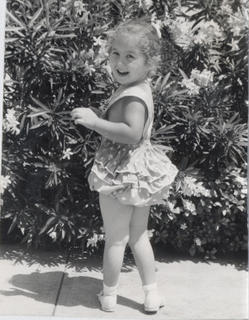Wednesday, August 30, 2006
And I Love Them
In a nostalgic mood--and nursing a bad cold--I present you with
AND I LOVE THEM
BY GEORGINA MARRERO
Certain things of note in my life sandwiched themselves between the summers of 1963 and 1964. Two of them affected the entire nation… if not the world. Even I – as an eight to nine year old – realized that nothing was ever going to be the same, again.
In July of 1963, we, as Cuban refugiados (or exilados, as we like to refer to life in the U.S. as living in El Exilio) began to aspire to The American Dream. Papi was a third year resident in neurosurgery at Jackson Memorial Hospital. To paraphrase my mother: “His salary – at $219 per month, as well as his age – at 53, were record-setting. He was the oldest resident in JMH’s history.” Given his knowledgeable background, extensive training, and years of experience, he had been appointed Chief Resident.
My sweet natured, shy – yet gregarious, at times – father had befriended many of the staff at the Jackson. A tall, lanky, bow tie clad, pipe-smoking Tennessean had become his special friend. He called my father, “Fred.”
Basil Yates, who figured in our lives for many years to come, came to our financial rescue. Estábamos muy apretados: we didn’t have much money. As my mother used to tell the story: one day, Basil asked Papi how much money he made per month. Papi replied, “two hundred nineteen dollars.” Was it enough to support a family, Basil then asked him. My father, in all honesty, replied, no. Whereupon, Basil reached into his wallet, pulled out two hundred dollars, and handed the money to my – I’m sure –astonished father. He told Fred he’d continue to do this until his friend finished his residency… to which Papi responded, “I’ll pay you back.” Both men kept their ends of the bargain.
So we were able to move from the kindly, shabby tenement, El Vanta Koor (Vanta Court; now Shenandoah Square), to a better apartment building several blocks away. We were still in La Sauguasera, el barrio close to Calle Ocho that was – and continues to be – inhabited by recently arrived immigrants and refugees. Mami and I could still walk to Calle Ocho. Most importantly, I could still walk to Shenandoah Elementary School, where I would begin fourth grade in the fall.
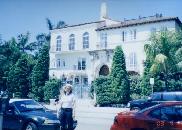
The Amsterdam Palace
Armed with Basil Yates’ generosity, we were able to spend a month at DA BEECH – as Miami Beach’s yearlong residents lovingly refer to their special place in the sun – that July. We rented an apartment in the Amsterdam Palace Hotel (now the Casa Casuarina). We had the middle oceanfront apartment on the second floor.
There was no air-conditioning… but that’s the way Mami wanted it. Las brisas del mar – the ocean breezes – provided plenty of cross-ventilation. Poor Papi was on call thirty-six out of every forty-eight hours, but, at least, he got to sleep in the alcove directly facing the window overlooking the front of the hotel. He rightfully had the best room in the house!
For my part, I played among the statues and fountains on the first floor, ceaselessly rode up and down the elevator, and spent as much time in the ocean as I could. Sometimes I went swimming twice a day. Mami liked to take me in the early mornings, when the sandbanks were built up, and we were able to walk out into the ocean as far as we dared. Also, we were less likely to become sunburned. Oh, really?
My certain thing of note number one was this: I became very tanned that summer. And I remember getting a really bad sunburn: it hurt, and then I peeled for what seemed like forever. However, I kept going back into the water, playing like a porpoise without a care in the world. After all, I was eight going on nine.
DA BEECH held other wonders: The old, decrepit Art Deco hotels; The old folks rocking themselves on the porches of these hotels; The old cafeterias on Washington Avenue, where a little money bought a lot of food; The fifty-cent theaters, often serving up double portions of old – but wonderful – movies. And then there was Wolfie’s.
Already a bit on the chubby side, I could always find room for more. Wolfie’s was a treat: from Tenth Street, we had to trudge up Collins Avenue to Lincoln Road, so I already had an appetite ready and waiting by the time we got there. I remember the pickles, the cole slaw, the rolls, the stuffed cabbage… and the cheesecake. Oh, that cheesecake…
Sunburn. Yes. There’s a picture of me at a party, sitting next to Papi, where I’m muy bronceada y rosada, all at the same time. Very bronzed and rosy, indeed, after all that Nivea, all that peeling: I’m wearing a white shift with big roses on it. For some reason, I’m shyly looking down at my hands. Papi is glancing over at me. And – yes – for some reason, this is the way I remember myself from the summer of 1963.
Late summer found us in the new apartment. For three years, I had all but stumbled out of bed to get to school, as El Vanta Koor is located next to Shenandoah Elementary School. Now I walked to school, either with Mami, or with some of our new neighbors’ children, who had become my new friends.
As my English had improved tremendously, I fully expected to find myself in an English speaking fourth grade classroom. Full of both eagerness and dread, I entered the fully mainstreamed classroom. To my horror, I found myself being directed back to my third grade bilingual classroom! Was I being held back?
It turned out a number of us were in the same predicament. All of us were cubanitos. We had all done well enough in third grade… but, perhaps, not well enough? Our old/new teacher instructed us to sit down at a separate table, and that is where we remained all year. We weren’t being held back: we were being both linguistically and culturally enriched. Shenandoah – along with Coral Way Elementary – had one of the pioneering bilingual, bicultural programs in the nation.
Our teacher was Puerto Rican. She offered us bilingual instruction, but only when – and if – she had to. I had been her third-grade classroom spelling champion the year before, having achieved the honor with the word, “handkerchief.” Slowly, but steadily, my grades had improved over the course of my first three years. No F’s since the six I had received in first grade, when I had spoken absolutely no English. However, I kept receiving my fair share of D’s… in Physical Education.

It was around that table that Mrs. Echevarria’s “transitional” fourth graders experienced certain thing of note number two: on Friday, November 22, 1963, at just after two p.m., our principal, Miss Hatfield, made an announcement over the loudspeaker. President Kennedy had been shot and killed. We were instructed to stand up, observe a moment of silence, and then we sang “God Bless America.”
Were we allowed to go home early? I’m not sure. What I do remember is that I – along with my mother and some neighbors – watched the world, as we knew it, change in front of our eyes over the course of the next four days. I remember watching Walter Cronkite – “Uncle Walter,” as I call him to this day – choke up in front of national TV. I have a fleeting memory of the shot fired by Jack Ruby that killed Lee Harvey Oswald. I remember the grimness on LBJ’s face as he took the Oath of Office, with Lady Bird and Jackie flanking him on either side. I remember Jackie draped in black. I remember the solemn procession of the horses at the funeral. And I remember John-John saluting his father.
What I didn’t know at age nine was that several cubanos were considered to be accomplices in the assassination plot. Playa Girón – The Bay of Pigs invasion – had been mapped out at El Vanta Koor. This I knew, even as a child.
Of course, we know by now that we may never really know. This nine-year-old cubanita really knew only one thing: the President of the country that had welcomed us three years earlier was dead. And we felt very sad.
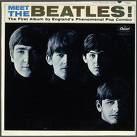
As fourth grade coursed along, though, the course of actual world history slipped into the background. By the end of 1963, my friends and I had begun to listen to four young men from Liverpool, England, blaring forth, “I wanna hold your hand,” in a way that shocked our elders. The Era of The Beatles had begun: this became our certain thing of note number three.
At least one of us muchachitas had the hit single in her hands by some time in January of 1964. I remember that we played it, over and over… and sang along, of course. Loving – nay, being in love with – The Beatles was quite the “girl” thing.
Whom did we love the most? Paul. And John. And George. And Ringo. In that order, because the “cuteness” factor was as – if not more – important to my prepubescent friends and me than their actual degrees of talent. I think some of our friends who were boys actually became quite jealous.
Everyone watched The Ed Sullivan Show in those days. On Saturday, February 7, 1964, The Beatles landed at Idlewild (now JFK) Airport, to mobs of screaming girls. On Monday, February 9, 1964, they made their first appearance on Ed Sullivan. Even before Ed had finished introducing “these youngsters from Liverpool,” the screams had begun, again. Wails, sobs, hand wringing… and tears. I could barely hear The Fabulous Four. I was probably screaming right along with the loudest of them.
Exactly one week later – on Monday, February 16, 1964, The Ed Sullivan Show was aired live from The Napoleon Room at the Deauville Hotel, on Miami Beach. I don’t remember knowing anyone who had tickets. Oh, if only…
At least we had the singles, and, later on, their first album, “Meet The Beatles.” I wish I remembered my mother’s reaction to “these youngsters.” She probably didn’t like them too much. Another of “mis manías” – my obsessive habits - she probably thought.
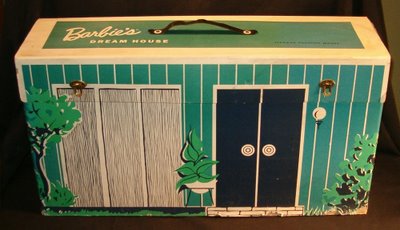
She’d already had her fill of my other one: my Barbie dolls. Though they didn’t have much money, my parents sweetly – and patiently – nurtured this other “girl” craze of mine. I lacked nothing: doll carriers; outfits; the orange sports car; the huge red bed (I’d wanted the pink canopied one, instead); the vanity; and the piano that played “I Love You Truly.”
Sometime between 1963 and 1964, they bought me the ultimate Barbie possession.
Barbie’s Dream House was made out of hard cardboard, with room dividers – and furniture – also made out of cardboard. It folded up, neatly, into an oblong “purse,” of sorts, for easy storage, and it had a handy-dandy black plastic handle. Still large and cumbersome, the house took some effort for even a chubby nine-year-old to lug around. Huffing and puffing, I managed. Proudly. Usually, though, it sat on the floor in the alcove where I used to study, right behind my desk.
And that’s where my certain thing of note number four occurred: right behind my desk. Rocking back and forth in my chair one day, I toppled backward. And squashed my Barbie Dream House almost beyond recognition.
I know I cried.
The summer of 1964 we moved to Milledgeville, Georgia. I was mainstreamed for the rest of my schooling. I remained addicted to The Beatles, and to my Barbie dolls, for several more years. My Papi eventually returned to Miami, and so did Mami and me.
But nothing would ever be the same, again.
Copyright, 2004 by Georgina Marrero 1942 words All Rights Reserved
Monday, August 14, 2006
The Perils of the Gables
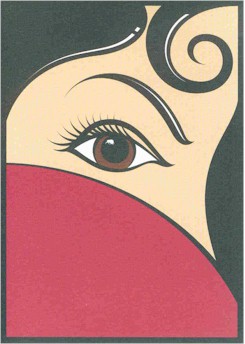

A Chocolate Lab and Carmen?
THE PERILS OF THE GABLES
BY GEORGINA MARRERO
Picture a perfect mid-winter early afternoon in Coral Gables. The sun is warmly shining down on the house, attempting to heat the stucco walls from within. Its rays are producing a ripple effect as they cascade across the maple-colored window treatments of the Florida Room. They also play hide and seek with the jackets and purses I have casually strewn over my comfortably high backed, spindly-legged Italian café table chairs. Bright, airy, cheery: I dart in and out of this glorious room, only subliminally absorbing its essence.
Instead, I hibernate in my cave of a study. The shades are always drawn; the light is always on. The air handler comes on intermittently, allowing a shaft of cool air to enter the room. As the cranking on of the compressor outside always presages the air handler’s gentle murmur, I barely notice its existence.
Until I don’t hear that cranking, that sometimes feels as if it’s jumpstarting the entire household. Until I don’t feel the slight breeze that usually tickles me in a corner of the room. Until the multi-megahertz phone bleeps, and I realize what has happened. We’ve had a power outage.
Rushing to the phone, I’m greeted by a blank answering machine screen, and by the ominous message: Out of range, on the receiver’s screen. At least the battery is vainly struggling to stay alive.
More proof: I need more proof. The yellow trouble light on the LCD alarm panel is all I need to make the final, irrefutable diagnosis: power outage.
And yet, I rush to the kitchen. Indeed: PF – Power Failure, in bright, yet discreet, red letters – screams out at me from the LCD panel on the stove. And then: blank. Every screen is blank. For I’ve heard another bleep. No mistaking it this time.
The Florida Room continues to be a cheerful oasis, but my inner sanctum is as dark as a tomb. FPL, I must call FPL, I tell myself. Grabbing my most powerful flashlight, I venture into my cavernous study closet, and unearth the latest FPL statement. At least the phone calling shouldn’t be a problem, as I have a “normal” enough phone set up in my bedroom.
My Barbie phone, indeed, works without juice. So I call FPL to get the cold, hard facts. Yes, we’ve had a power outage. 952 customers have been affected. All my neighbors for at least a bunch of blocks, I gather. I give the kindly FPL automaton my cell number to keep me apprised.
It’s 12:30 p.m. Still exhausted from a less than perfect night’s sleep, in my pajamas, with the bed as rumpled as the moment when I raised my head from my pillow several hours earlier, I decide to take the old adage up on its wisdom: if you can’t beat ‘em, join ‘em. So I put on my night blinders, curl up under the covers, and hope for the best.
Best has its limits. At around 1:20 p.m., Bizet’s Carmen booms in my ears. FPL has just contacted me via my cell phone with its first message: yes, there’s a problem. It’s with their equipment, and it should be resolved by 2 p.m.
Back to bed is easier said than done. I decide, hey, I can’t sleep, I can’t write, but I can eat. So I open a can of tuna, take some dry toast out of the cupboard, and open the refrigerator an instant to retrieve some salad dressing. Out, in. Everything seems to be holding up.
With that taken care of, I decide I’ll spend some time outside. Cleaning my grubby patio set as best I can, I settle down to a much-anticipated session with the tidbit-full December issue of Vanity Fair. Perfect: it’s so warm, so sunny, and I feel so cozy in my pajamas. There’s nothing that can interrupt me now, I say to myself. Just a little bit longer, right?
Carmen soon pays me another courtesy call. FPL has arrived on the scene of the problem, but, alas, it’s going to take longer to fix: more like until 4:30 p.m. or so. Fortunately, I have until 6:30 p.m. before I must switch opera channels, as I’m to go see The Magic Flute with my fellow opera-loving friend this evening.
So I settle in for the duration, as happy as all the lizards and birds that surround me. Until several weeks ago, no other creature would have dared interrupt my blissful read. However, I now share a ficus grove with my neighbor’s boyfriend’s chocolate Labrador. A sweet hog for attention, he’s become my friend: I’m his ball buddy.
Lying on the grass on his side of the fence, he sees me and clambers up on his hindquarters until I give him a tentative pet. He then briefly licks my hand, and, as he’s gotten in the habit of doing whenever he sees me, he goes to fetch his saliva and grass encrusted ball. It’s playtime.
Not now, I tell him. I really want to catch up with my Vanity Fair. No sooner do I begin to read, than he begins to whimper. Persistently. OK, you win, I tell him, as I reluctantly put the magazine down, stroll over to his side of the gate, and begin our give and take. Soon my hands are saliva and grime streaked, but, looking into his eyes, I know I’ve made him happy. And – I realize – he’s made me happy, too.
May I have a reprieve, I finally ask him, as I go inside, wash my hands, and attempt to return to my reading. He whimpers a bit more, but realizes it’s my turn to have my kind of fun.
With cell phone in front of me, I tackle Graydon Carter’s version of the truth. Soon enough, I’m so immersed in the magazine that the next two or so hours melt away. Before I know it, Carmen rings, yet again.
FPL’s Merry Automaton has a cheerful message for me this time: your problem should be fixed. 952 customers had lost their power due to downed branches.
Mid to late afternoon sun is beginning to filter through the Florida Room. I run around the house resetting all the clocks. Soon afterward, I shower and get ready for my opera-loving duet.
The next time I hear Carmen, it’s my friend, Carmen, telling me she’s on her way.
So ends a Tuesday. On Thursday, however, I awaken to the very loud chirping of a bird. He’s almost at my ear, or so it seems.
This, however, is no bird. It’s the trouble light on my LCD alarm panel. Fussing with the controls, I soon unearth the problem: the battery in my second bathroom windowsill needs to be replaced. And until it is, that little yellow light will bug me to no end.
If it isn’t one thing, it’s always another. Such are The Perils of The Gables.
However, I can always count on my neighborly chocolate Lab… and on Carmen.
Copyright, 2005 by Georgina Marrero 1162 words All Rights Reserved
Tuesday, August 01, 2006
Am I Ready? Are We Ready?

Several blocks removed from US 1 in South Miami last night, I didn't hear it--
The comments I posted on Ana Veciana-Suarez' blog earlier this afternoon:
Little did I know when I was celebrating a friend's birthday last night, drinking more than my usual wont, what else was going on. The last time El Barbabudo chose to give us "a scare," I remember having been in a restaurant, and beginning to cry. The Cuban anthem began playing in my mind almost immediately. The Cuban in me can't wait for the jubilation; the (I hope, responsible) Cuban-American in me dreads the pandemonium. The feeling that's building up in me--that of the six year old who said goodbye to her record player and most of her dolls on a Saturday in late October almost forty-six years ago--is almost beyond emotion. Am I ready? Are we ready?
